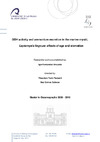Identificador persistente para citar o vincular este elemento:
https://accedacris.ulpgc.es/jspui/handle/10553/7224
| Título: | GDH activity and ammonium excretion in the marine mysid "Leptomysis lingvura": effects of age and starvation | Autores/as: | Fernández-Urruzola, Igor | Director/a : | Packard, Theodore T. Gómez, May |
Clasificación UNESCO: | 251001 Oceanografía biológica | Palabras clave: | Glutamate dehydrogenase Ammonium excretion Leptomysis lingvura Starvation Body size |
Fecha de publicación: | 2010 | Proyectos: | Estudio de Un Nuevo Modelo Mecanistico Para El Metabolismo Del Zooplancton | Resumen: | Ammonium (NH4+) release by bacterial remineralization and heterotrophic grazers determines the regenerated fraction of phytoplankton productivity, so the measurement of NH4+ excretion in marine organisms is necessary to characterize both the magnitude and the efficiency of the nitrogen cycle. Glutamate dehydrogenase (GDH) is largely responsible for NH4+ formation in crustaceans and consequently should be useful in estimating NH4+ excretion by marine zooplankton.<br />Here, we address body size and starvation as sources of variability on the GDH to NH4+ excretion ratio (GDH/RNH4+). We found a strong correlation between the RNH4+ and the GDH activity (r2 = 0.87, n = 41) during growth. Since GDH activity maintained a linear relation (b = 0.93) and RNH4+ scaled exponentially (b =0.55) in well fed mysids, the GDH/RNH4+ ratio increased with size. However, the magnitude of its variation increased even more when adult mysids were starved. In this case, the GDH/RNH4+ ratio ranged from 11.23 to 102.41. | Descripción: | Máster en Oceanografía | Facultad: | Facultad de Ciencias del Mar | URI: | https://accedacris.ulpgc.es/handle/10553/7224 |
| Colección: | Trabajo final de máster |
En el caso de que no encuentre el documento puede ser debido a que el centro o las/os autoras/es no autorizan su publicación. Si tiene verdadero interés en el contenido del mismo, puede dirigirse al director/a o directores/as del trabajo cuyos datos encontrará más arriba.
Vista completaVisitas
48
actualizado el 10-ene-2026
Descargas
69
actualizado el 10-ene-2026
Google ScholarTM
Verifica
Comparte
Exporta metadatos
Este elemento está sujeto a una licencia Licencia Creative Commons

